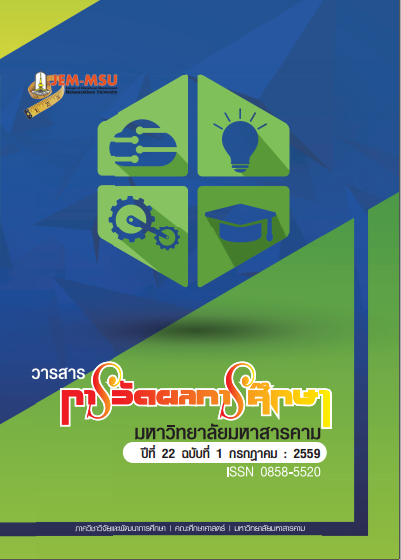An Evaluation of the school curriculum on English/ Science/Communication of Mahasarakham University Demonstration School (Elementary)
Main Article Content
Abstract
A curriculum evaluation is the process of finding data and using the data for
implementing in improving and developing curriculum to be relevant to current social
conditions. This study aimed to evaluate implementation of evaluation of the school
curriculum on English/ Science/Communication of Mahasarakham University Demonstration
School (Elementary) by employing CIPP Model. The sample consisted of 60 administrators
and teachers, 120 parents and 125 students, obtained using the purposive sampling
technique. Two types of instruments used for collecting data were 3 5-rating-scale
curriculum evaluation forms : Form 1 with 64 items for administrators and teachers, Form 2
with 64 items for parents and Form 3 with 23 items for students with a discriminating powers
ranged from .27 to .79 and an overall reliability of from .98 .98 and .98; and a 6-item
structured-interview form for students. The statistics used for analyses of collected data
were percentage, mean, and standard deviation.
The results of the study were as follows:
1. In context, the evaluation administrators and teachers view congruently that
the Curriculum goals were appropriate at the high level. The goals emphasized learners to
use the knowledge in daily life, the school curriculum on English/Science/Communication of
Mahasarakham University Demonstration School (Elementary) harmonize with the Basic
Education Core Curriculum 2008 Curriculum Structure
2. In input
2.1 The administrators and teachers viewed that some teachers well-behaved
and being a good role model for the students, seek more knowledge and use new
instructional innovation medias for improving learning and teaching managements, specials
classes such as, language laboratory, computer laboratory are enough for learning and
teaching.
2.2 Parents viewed that the school use new instructional innovation medias
worthily and has good learning atmosphere. Teachers dedicate themselves for public
interest, well-behaved and being a good role model for the students, creative thinking for
learning and teaching managements.
2.3 Students viewed that teachers have creative thinking for learning and
teaching managements and have abilities for learning and teaching by using English
language, seek more knowledge and use new instructional innovation medias for improving
learning and teaching managements.
3. In process
3.1 The administrators and teachers viewed that the school encourage
teachers to manufacture instructional innovation medias, encourage the school personnel to
improve their abilities in duties ; such as observing activities and further study.
3.2 Parents viewed that the school use new instructional innovation medias
worthily and has good learning atmosphere. Teachers dedicate themselves for public
interest, well-behaved and being a good role model for the students, creative thinking for
learning and teaching managements.
3.3 Students viewed that the school have many different learning and
teaching managements. Teachers have new instructional innovation medias worthily and has
good learning atmosphere.
4. In product
The administrators and teachers viewed that the quality of learners was
appropriate at the high level. That was, the learners could develop themselves according to
their own potentials in terms of knowledge and responsibility. Students could use English to
communicate with foreign people, pass high school entrance examination in English
Program. In conclusion, the school curriculum on English/ Science/Communication of
Mahasarakham University Demonstration School (Elementary) was appropriate at the high
level in every aspect. Therefore, this curriculum should be implemented further. However,
guidelines for developing the curriculum to be appropriate at the highest level should be
sought to develop the quality of learners to achieve the established purposes in the future.
Article Details
The content and information contained in the published article in the Journal of Educational Measurement Mahasarakham University represent the opinions and responsibilities of the authors directly. The editorial board of the journal is not necessarily in agreement with or responsible for any of the content.
The articles, data, content, images, etc. that have been published in the Journal of Educational Measurement Mahasarakham University are copyrighted by the journal. If any individual or organization wishes to reproduce or perform any actions involving the entirety or any part of the content, they must obtain written permission from the Journal of Educational Measurement Mahasarakham University.


